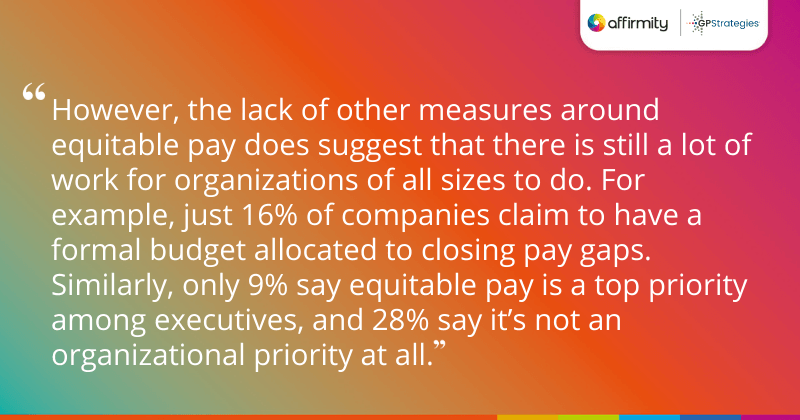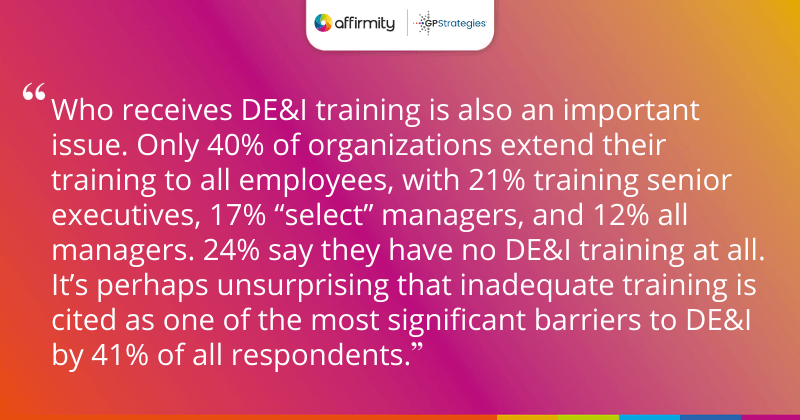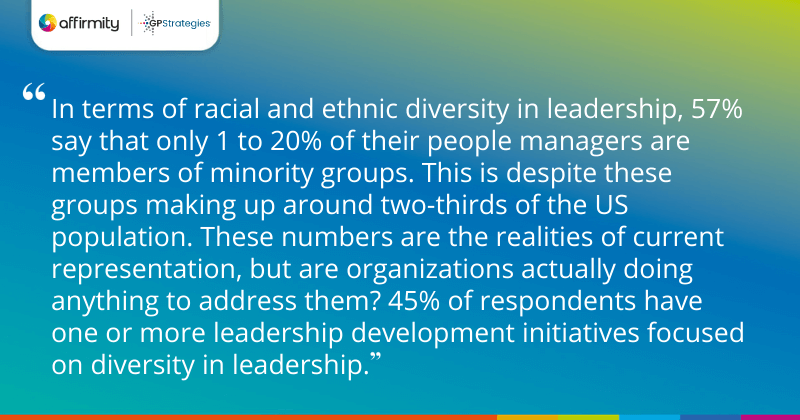What is the state of play for DE&I in 2022? The recent Affirmity-sponsored HR Research Institute study, ‘The Future of DE&I 2022’, surveyed HR professionals on how diversity, equity, and inclusion are executed in their organizations. In this blog post, we’ve picked out some key highlights that help underline how much remains to be done—and some of the best tactics for getting it accomplished.
1) Organizations Continue to Lack Diversity in Their Leadership Ranks
47% of respondents say that women represent no more than 40% of the people managers in their organizations, and only around 26% believe that their organization has roughly equal male/female representation. In terms of racial and ethnic diversity in leadership, 57% say that only 1 to 20% of their people managers are members of minority groups. This is despite these groups making up around two-thirds of the US population.
These numbers are the realities of current representation, but are organizations actually doing anything to address them? 45% of respondents have one or more leadership development initiatives focused on diversity in leadership. Other measures, such as having a mandate to increase diversity in leadership, are more rare.

2) Most Companies Fall Short in Terms of Metrics Measurement
Only one-fifth of organizations say they actually know how effective their DE&I programs are, and two-fifths cite a lack of metrics with which to identify DE&I shortfalls as a major barrier in the effectiveness of their initiatives. Furthermore, where metrics are available, they tend to meet only the minimum requirements. 56% of companies collect only this basic workforce data—i.e. data about legally protected traits such as gender.
Clearly, such measurement is important. However, a well-rounded approach to measurement data should also consider elements such as diversity in leadership ranks (42%), diversity among teams (41%), and employee engagement and satisfaction levels (48%). There is also a lack of measurement of diversity goals related to succession planning and management (just 23% claim to measure this area). Most worryingly, 16% do not measure DE&I at all.
CONTINUE EXPLORING METRICS | ‘Your Diversity Metrics: How to Break Down Employee Data and Benchmark Representation’
3) Many Companies Are Also Failing on DE&I Training
Certain types of DE&I training have made significant inroads into the curriculums of businesses. 69% of organizations now provide unconscious bias training to their employees and 55% offer inclusion awareness training. However, the absence of a large variety of topics beyond this points to the lack of a wider framework driving change. Fewer businesses run conversations training (48%), inclusive recruitment policies training (42%), conflict resolutions training (33%), or DE&I-specific communications practices training (23%).
Who receives DE&I training is also an important issue. Only 40% of organizations extend their training to all employees, with 21% training senior executives, 17% “select” managers, and 12% all managers. 24% say they have no DE&I training at all.
Considering the numbers of those that don’t train, those that limit the reach of their training, and those that lack certain types or a wide spread of DE&I training, it’s perhaps unsurprising that inadequate training is cited as one of the most significant barriers to DE&I by 41% of all respondents.
FURTHER THOUGHTS ON TRAINING | ‘4 Steps to Help You Flip Your Classroom and Shake Up Your Inclusion Training’

4) There’s Room for Improvement in Equitable Pay
48% of all respondents to the survey state that they believe pay is equitable in their organization. However, this response decreases greatly with organization size: 65% in small, 52% in mid-size, and 33% in large organizations. There are many factors that could explain this—larger organizations are more likely to be compelled to make their pay disparities common knowledge, for example. Furthermore, scale inevitably makes equitable pay more complex to administrate.
However, the lack of other measures around equitable pay does suggest that there is still a lot of work for organizations of all sizes to do. For example, just 16% of companies claim to have a formal budget allocated to closing pay gaps. Similarly, only 9% say equitable pay is a top priority among executives, and 28% say it’s not an organizational priority at all.
In terms of equitable pay measurement, 55% use comparisons of pay among comparable jobs, and 41% use comparisons within pay bands. Only 10% factor in either comparison of bonuses and stock options, or use regression analysis.
MORE FROM THE BLOG | ‘3 Steps Towards a More Inclusive, Equitable, and Attractive Working Environment and Identity’

5) The 8 Tactics DE&I High Performers Typically Use
As usual, the ‘Future of DE&I’ research report has sorted respondents into high- and low-performance groups based on how they rate their organization’s DE&I maturity. This allows for the observation of some common traits and tactics among high performers. These include:
- Supporting the closing of pay gaps with budget and directives from the top of the business
- Considering a wide range of characteristics in DE&I work
- Integrating DE&I strategic frameworks into business strategies with the goal of making DE&I more visible to employees at every level
- Including DE&I in both talent acquisition and succession planning processes
- Relying on more advanced metrics while setting a greater number of DE&I-related goals and using more incentives to encourage DE&I best practices
- Training employees on pay equity, communication, anti-racism, inclusion awareness, and inclusive recruitment policies
- Operating programs to improve diversity in the leadership ranks
- Focusing on more inclusive, family-friendly benefits
